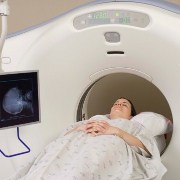 Photo: Getty Images
Photo: Getty Images
The development of the MRI has been a great boost for medicine. This relatively new imaging technique has helped doctors diagnose many medical disorders much earlier. However, because the devices use high magnetic fields, certain patients were not eligible for MRI procedures. Performing MRI procedures on patients with pacemakers, aneurysm clips, surgical staples, mechanical heart valves and implanted defibrillators (ICS) has always been forbidden.
It was thought that the strong magnetic field would loosen the surgical staples, make the pacemaker fire erratically, or that the device would interfere with the examination and pose a serious health risk. These health risks associated with MRI procedures were obtained from the results of animals that underwent serious heating injuries in the presence of a metal device. In addition, there is documented evidence that some patients with pacemakers have also died after MRIs.
Now, a study from Spain revealed that perhaps we were unduly worried. The Spanish study revealed that performing MRIs on individuals who already had pacemakers or implanted defibrillators (which were not designed for use in MRI procedures) appears to be safe. The study was done on 118 patients who suffered no adverse effects from the MRIs. Only a few patients had mild changes in the electrical parameters, but there were no clinical consequences. Dr. Oscar Cano Perez, M.D., from the Hospital Universitari i Politècnic La Fe de Valencia in Spain, credited the good results to a safety protocol that had been established (1).
As far as earlier deaths related to pacemakers, Perez mentioned that in the earlier studies, the patients had older generations of pacemakers. There are now recent studies done on patients with newer generations of pacemakers and implanted defibrillators, which indicated that the MRIs had been completed with no complications.
In the US, the FDA is not convinced. Just recently, the agency approved of a pacemaker specifically designed for safe use in the MRI environment (2). In any case, anyone who wants to perform MRIs in the US on patients with pacemakers or implanted defibrillators should ensure that they have an experienced cardiologist and full resuscitation equipment ready at the site. Otherwise, there will be a lot of explaining to be done to the malpractice lawyers waiting just outside the hospital grounds.
Sources:
1. Europace: MRI safe for use with implanted devices. http://dieurope.com/articles/e-news/details/article/europace-mri-safe-for-use-with-implanted-devices/index.html
2. New wave of MRI-safe pacemakers set to ship to hospitals http://www.scientificamerican.com/blog/post.cfm?id=the-new-wave-of-mri-safe-heart-devi-2011-02-16
Reviewed August 3, 2011
by Michele Blacksberg R.N.
Edited by Kate Kunkel






Add a Comment5 Comments
please do read the article well before writing. the conclusion says that the FDA is not convinced by this Spanish study. And the end says any doctor wishing to do MRI on such patients better have good medical malpractice insurance. Read before you leap.
August 3, 2011 - 10:45amThis Comment
Oh please, this is just a representation. Most doctors would not be able to tell the difference between an MRI or CT scan machine. Supply us with a picture and we will be glad to put it up there.
August 3, 2011 - 10:41amThis Comment
PS: The picture accompanying the article is of a CT scanner, not an MRI scanner.
August 3, 2011 - 10:24amThis Comment
I think that this study is methodologically-weak. An analogy would be if I blindfolded myself, walked back and forth across an interstate highway 10 times without injury, and published a paper stating that blindfolded-highway crossing was proven safe.
What about lead-tip heating? If it created scarring at the lead tip, many pacers would automatically increase the voltage needed to stimulate the cardiac muscle. Perhaps, as a consequence, a 5-year battery life gets shortened to 3-years, but that's an adverse event that wouldn't be uncovered by anything less than inspection and testing of the lead-implantation site.
I'm not suggesting that the conclusions of the study are incorrect, but rather that the methodology doesn't support the conclusions they put forward. What constitutes a 'modern' pacing device? What are the lead lengths, materials, and configurations? What about static field strength, gradient fields, RF frequencies and deposition? What about the clinical parameters for the patients? Are we talking about capture and correction pacer patients, or complete device dependence patients?
This study may have anecdotal value, but as with similar studies, the leaped-to 'sound bite' conclusion that MR imaging of patients with pacing devices is safe does a disservice to clinicians and patients alike. Yes, it may well be possible to image a particular patient, with a particular pacing device, on a particular scanner, set to specific sequences, with appropriate special provisions in place, but that is a far cry from the freedom of most MR imaging.
August 3, 2011 - 10:22amThis Comment
No one is claiming that MRI is a bad instrument. But i have yet to come across one radiologist who will willingly place a patient with a non-approved pacemaker (or for that matter any metal) in an MRI machine.
August 3, 2011 - 10:38amThis Comment